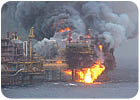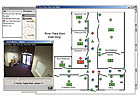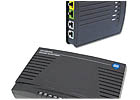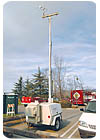CONVERGANCE STRATEGIES (SPECIAL REPORT): Putting the VoIP Fire Out

Illustrated at left is an example of the potential of IP-based technology for fire and life safety. In this screen graphic, the smoke spread in the facility is clearly shown by the red diamond icons in alarm. The fire is found in classroom 101, which displays an icon characteristic of a rate-of-rise alarm. In addition, the path of the intruder is clearly displayed by the motion detectors in a recently in alarm state, with the exception of the icon located at the exit door, which is currently in the alarm state – indicative of an intruder currently leaving the building.
Just as the personal computer industry has had to change due to its convergence with wireless, home automation and entertainment technologies, enterprise security is currently entering a period of technological convergence. Discrete security technologies are being reengineered under the guise of becoming IP-addressable network appliances. It’s especially apparent with the emergence of VoIP (Voice over IP) technologies. Now becoming part of the IP vernacular, VoIP’s impact on security has yet to be quantified.
While some end-users rave about VoIP, monitoring companies label them as dangerous since they have grave repercussions for legacy security systems. According to an open letter from a security industry lobbying entity, VoIP does not allow the alarm panel to seize the phone line to signal the central station, and it does not allow for backup power to the alarm panel.
VoIP monitoring problems
To illustrate, in several tests problems have been reported that the tones intended for the central monitoring station receivers do not reliably propagate over some VoIP channels. Sometimes these transmission failures are the result of protocol conflicts, while other times they result from distortion of signals on the lines.Some companies have tested panels using different VoIP applications and have reported marginal results. Some formats do not function at all, while others had to resend multiple times in order to be successful. VoIP varies its compression based upon the available bandwidth. These problems will adversely affect VoIP conversion by alarm system owners since failure of these systems could result in loss of life and property. This opens the possibility of substantial liability. Some operations have tried to solve the problem using an IP-based system with long-range radio backup. Most of these setups made no provision for battery backup or 24 hours of standby.
While the standards for transmission of security signals to off-site locations are primarily specified by industry groups, the standards for the transmission of fire alarms and their supervisory signals are subject to legal enforcement. In particular, the NFPA 72 National Fire Alarm Code does not prohibit transmission means other than POTS – an acronym for “plain-old telephone system – but whatever method is chosen must be compliant with NFPA 72 standards. These compliance issues will necessitate the industry to take a slow, cautious approach to the use of VoIP as an alternative to POTS in conventional panels using Digital Alarm Communicator Transmitter or DACT-based communications.

A new generation of VoIP gear, for example this VoIP terminal adaptor from InnoMedia, will help spread IP technology but with consequences for security and life safety systems.
Quick track to plan
Recently, the alarm industry, through the auspices of the Alarm Industry Communications Committee (AICC), has attempted to educate VoIP providers of these issues and try to work out a mutually beneficial and rapid solution. The AICC is a pan-association group, made up of the three main associations in the industry: the Security Industry Association, the National Burglar and Fire Alarm Association and the Central Station Alarm Association. The AICC, working together with the VoIP providers, should move quickly to adopt a plan for communications compatibility.Alternatively, manufacturers have developed panels compatible with IP-enabled DACTs. These communicate directly to central stations using a point-to-point broadband connection, thus eliminating the problems of VoIP connectivity. Clearly, once the market demands panels compatible with VoIP communications, manufacturers will likely introduce panels using VoIP-compatible DACTs. In both cases, these panels will offer increased communication speed but do not address the potential for increased information content useful in assessing the nature of the emergency.

Wireless also plays a fire and life safety role. Verizon Wireless network employees power-up a mobile cell site to enhance coverage around the field headquarters of the Orange County Fire Authority at Irvine Park near Villa Park, Calif. The mobile cell site was deployed to meet the communication needs of hundreds of firefighters and others drawn to the area by wind-driven 3,500-acre wildfires threatening southern California communities. Photo courtesy: PRNewsFoto/Verizon Wireless
In time, the industry will reexamine the traditional role of security and fire alarm systems. In the case of a security alarm system, its primary function is to monitor a space, detect an intrusion and notify a monitoring station of an alarm or a problem. Traditional security alarm systems do this well. What happens next is a function of the alarm type and the procedures used by the monitoring station responding to the alarm. This may include a call to security or the owners of the facility to verify the intrusion, a requirement to validate the alarm or a call to emergency services requesting assistance.
Fire vs. security alarms
In the case of a fire alarm system, the primary function is to monitor a space, detect a fire, evacuate the facility and notify a monitoring station of an alarm or a problem. Traditional fire alarm systems also do this well. What happens next is a function of the alarm and the procedures used by the monitoring station responding to the alarm. This includes a call to emergency services requesting assistance and/or a call to the owners of the facility to report the trouble.
The true promise of IP-based security and fire systems is their ability to deliver alarms faster with a corresponding increase in information content. The primary function of the security system of the future will be to monitor a space, detect an intrusion, track the course of the intrusion in real-time and notify a monitoring station of an alarm or problem while delivering this information to security or first responders in transit to the scene.
To achieve these goals, the future IP security system will need to be reengineered. For example, motion detectors have historically reported two states: not in alarm and alarm. Now presume that a third state, recently in alarm exists. Given this simple change, the humble motion detector is now able to track an intruder movement through a facility in real-live time. Given that a colored icon representing the current state of the sensor is placed on a graphic of the floor plan, security could track an intruder from the initial motion detector alarm state characterized by a change in color of the icon. Within a few seconds, the icon will change again to the recently in alarm state represented by a different colored icon. If the intruder is still in the room, the motion detector will go into alarm again. All of these activities are time-stamped and available for replay using tools similar to the controls of today’s DVD players.
If the intruder moves out of the room and into an adjoining hallway, the hallway motion detector then goes into alarm status. Intelligence programmed in the panel turns on the hallway lights. As the intruder walks down the hall, the nearest motion detector goes first into alarm and then into recently in alarm. The display now portrays the path in which the intruder walks through the building with the sensor currently in alarm indicating the current location of the intruder. For those with fans of Harry Potter in their family, the resulting system is similar to the Marauder’s Map, except that it manages a wholly different type of mischief.
To take this example one last step, presume that there are two intruders in the facility. If one of the intruders chooses to move down a hallway to the left and the second intruder down a hallway to the right, motion detectors placed in those hallways provide direct evidence that two or more intruders are in the facility. Now, strategically placed IP-based video cameras capture high quality graphic images of the intruders that can be displayed and stored at multiple monitoring sites.

As enterprises go to VoIP such as this BizFon IP-based key telephone system, the convergence challenge needs help from integrators, IT and equipment makers as gear moves from polling to push.
Push rather than poll
These new IP-based security panels push their alarms rather than poll for them. Consequently, all authorized monitoring stations view the alarms within seconds of occurrence. The icons act as easily discernible symbols without cluttering the screen and confusing the operator. The increased level of information displayed provides the operator with tools to recognize the presence of multiple intruders, the ability to discern a falsely triggered alarm (isolated alarming sensor) from a legitimate alarm and the visual tracking of their activity. Monitoring personnel can apply pattern analysis to real-time changes in alarm states to discriminate between false and genuine alarms, and to track intruder movement. As the alarms are pushed to multiple authorized monitoring sites – including first responders approaching the facility – the security system essentially becomes an emergency information system.The availability of real-time information provides first responders with virtual presence on the scene. When one considers the current trend of more and more municipalities adopting laws limiting response to only verified security alarms, there would be a new paradigm for response – thus changing the basic response profile while providing security and first responders a reason to trust and use information provided by the next generation of security alarm systems.
IP-based can also be applied as a reengineered fire system. In this case, the end-user installs classical smoke sensors, which display two icon, states not in alarm and alarm. However, the standard heat sensor is replaced with an intelligent digital temperature sensor. The digital temperature sensor displays the actual temperature of the monitored site and simultaneously displays a colored icon characteristic of the state of the temperature sensor. All changes to these sensors are reported simultaneously to all authorized monitoring stations within seconds of a state change.
The list of temperature sensor display states are then redefined as: not in alarm (green with the current sensor temperature displayed), early warning (orange with the icon displaying an elevated room temperature not characteristic of a critical alarm temperature) and alarm (red, where the sensor temperature displayed with the icon is characteristic of either a rate of rise alarm or a preset temperature threshold alarm).

More info over IP
Similar to the security system, the IP-based fire system now provides all authorized monitoring stations with information detailing the spread of smoke within the facility, and can precisely pinpoint the location of the fire in real-time. This capability has recently been demonstrated by tests performed at the Louisiana State University’s Fire Emergency Training Institute. All this information is simultaneously available to multiple authorized monitoring stations and to the responding fire department(s).In conclusion, the promise of reengineered IP-based security and fire alarm systems lies in their ability to provide all authorized monitoring stations with real-time changes to the sensor states, now defined as a change of state within 3 seconds of an alarm event. These IP-based systems are no longer just alarm systems in the classical sense but emergency information systems taking full advantage of a high-speed broadband communications network. These enhanced systems provide simultaneous information to multiple authorized monitoring stations located at geographically different locations.
Implementing these changes into conventional security and fire alarm systems clearly represents the promise of IP technology convergence. Unfortunately, it also presents a conundrum of having to choose between advancing the state-of-the-art by creating and deploying true emergency information systems, or just reengineered conventional alarm system technologies to use the increased speed of the IP connection to transfer alarm data faster but not necessarily better. The future has been defined, but are people listening?
Data on DACT
NFPA 72 Section 5-5.2 requires a DACT to be connected to two independent means of communications to a supervising station, the first of which must be a telephone line. The telephone line must be a loop start line, and may not be a ground start line commonly found on a Private Branch Exchange (PBX). Loop start telephone lines always have voltage present and therefore can be monitored for integrity. The second method of communication may be a cellular telephone, active multiplex, derived local channel, one-way private microwave, one-way RF or two-way RF.Looking for a reprint of this article?
From high-res PDFs to custom plaques, order your copy today!


